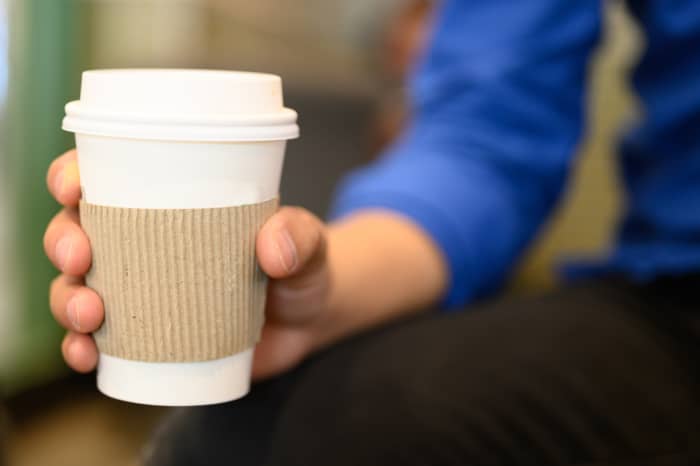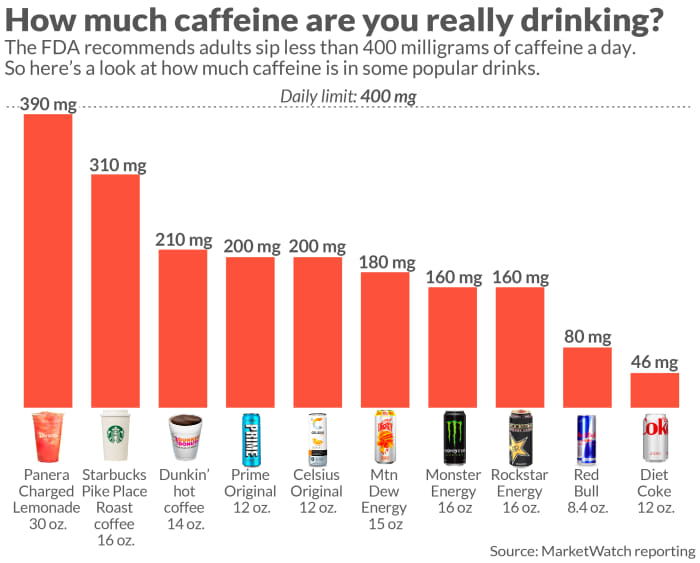A recent lawsuit against Panera Bread that implicates the chain’s caffeinated “Charged Lemonade” in the death of a college student with a heart condition may have given some folks renewed jitters about whether their go-to energy drink is still safe to sip.
The student, Sarah Katz, 21, drank Panera’s Charged Lemonade — which contains up to 390 milligrams of caffeine in a 30-ounce serving — in September 2022, according to the lawsuit filed in the Philadelphia Court of Common Pleas. She died later that day, and the suit brought by her parents accuses the chain of failing to warn consumers about its ingredients. The company was not immediately available for comment. But it is now displaying an enhanced disclosure about its Charged Lemonade, a spokesperson told NBC this week.
So, is 390 milligrams a lot of caffeine?
It’s quite a lot, in fact. Healthy adults should stick to less than 400 milligrams of caffeine a day, according to the FDA. The problem is that many of us are probably sipping more of this stimulant than we realize, maybe even well exceeding this recommended daily limit, which could pose health risks like insomnia, nervousness, restlessness, nausea, increased heart rate and other side effects.
But what does 400 milligrams of caffeine actually look like?

The amount of caffeine in your morning coffee depends on the portion size and also the concentration of coffee in your particular brew, so be sure to look up its nutrition content.
Getty Images/iStockphoto
Well, that’s about eight cans of Diet Coke (or 11 cans of regular Coca-Cola
KO,
soda), or four cups of home-brewed coffee, so you probably don’t have to worry about completely giving up on your favorite coffee or caffeinated drink just yet. (Well, unless it’s loaded with sugar, which is another story.) The FDA notes that a 12-ounce can of a caffeinated soft drink typically contains 30 to 40 milligrams of caffeine; an 8-ounce cup of green or black tea counts 30-50 milligrams; and an 8-ounce cup of coffee is closer to 80 to 100 milligrams.
It’s importation to know portion size, though. Keep in mind that a “cup” is 8 ounces, or smaller than what you probably consider a “cup” of coffee to be. So a single grande Starbucks
SBUX,
hot drip coffee, for example, is 16 ounces — or two cups of coffee, really. Many standard mugs or coffeehouse servings today are also set at 12 to 16 ounces.
What’s more, the caffeine content of different brews and drinks can vary widely. So on Starbucks’s site, a grande (16-ounce) Pike Place Roast coffee actually comes in at 310 milligrams of caffeine. In other words, that single Starbucks coffee drink is already almost hitting your daily recommended caffeine cap, before you consider the other caffeine that you might be consuming throughout the day from getting a second cup of coffee; sipping tea, soda or energy drinks; eating chocolate; or taking supplements. Some painkillers, like those targeting headaches, might also have caffeine in them.
“The American Academy of Pediatrics advises against kids under 12 consuming any caffeine, period. And the AAP recommends that teens 12 to 18 sip less than 100 milligrams of caffeine a day.”
The caffeine cap is even lower for kids and teens. In fact, the American Academy of Pediatrics advises against kids under 12 consuming any caffeine, period, writing, “There is no proven safe dose of caffeine for children.” And the AAP recommends that teens 12 to 18 sip less than 100 milligrams of caffeine (maybe two 12-ounce cans of soda) a day. But energy drinks like Celsius and Prime that are popular on TikTok may pack an over-caffeinated punch that easily exceeds that 100-milligram limit. A single 12-ounce can of Celsius Original contains 200 milligrams of caffeine, for example, while the Celsius Heat variety counts 300 milligrams of caffeine in a single 16-ounce can. That’s double and triple the recommended amount of caffeine for teens daily.
But on the flip side, Red Bull has a relatively low 80 milligrams of caffeine in a single 8.4-ounce can — well below that Starbucks coffee.
Caffeine counts can get confusing. So here’s a chart comparing the caffeine content of some popular coffees, sodas and energy drinks, to help you get a better idea of how close a single serving comes to pushing you over the recommended 400 milligrams of caffeine for adults each day.

MarketWatch
Health experts told MarketWatch that many people — and kids, teens and young adults, in particular — aren’t worried about their caffeine intake the same way that they may watch their sugar or sodium.
“I see a lot of younger patients, particularly young men, that are drinking these caffeinated drinks in the morning, or before they go to the gym, and the feeling is that it helps them perform better,” Dr. John Whyte, the chief medical officer at WebMD, told MarketWatch.
Indeed, a recent Mintel market report valued the U.S. energy-drink industry at $21.1 billion worth of sales in 2022, which is forecast to hit $22.7 billion in 2023, largely thanks to young men. “Energy drinks are largely a younger consumers’ category, with men aged 18-34 leading consumption,” it noted. But there’s plenty of potential to get more younger women on board, as “the narrowest gap exists between men and women for hybrid energy drinks (coffee, ice tea, etc),” it added.
“The biggest myth is that ‘caffeine doesn’t hurt me,’ because you don’t hear about it being regulated as much,” Whyte from WebMD continued, “and so people are more concerned about sugar and calorie counts than caffeine.”
Yet the FDA warns that toxic effects, like seizures, can be observed with the rapid consumption of around 1,200 milligrams of caffeine.
“Caffeine itself, remember, is a stimulant,” Whyte added. “It’s going to increase your heart rate. It’s going to increase your blood pressure because it’s going to constrict the blood vessels and make your heart work harder and make it go faster. And it may make you more dehydrated.”
And this can have a greater impact on kids and teens, who are drawn to energy drinks in particular, noted Dr. Mark Corkins, the chair of the American Academy of Pediatrics committee on nutrition. “Kids think [caffeinated energy drinks] are cool. It’s an ‘adult’ drink. And we all like our stimulants. They make us feel good,” Corkins told MarketWatch.
But higher concentrations of caffeine can hit younger consumers harder, because kids and teens are obviously smaller than adults. “For a kid, one cup of coffee [or one energy drink] is a bigger dose per kilogram [of body weight] compared to a grown man,” he said.
So what can we do?
First, be aware of the signs of caffeine overdose, which include:
- Insomnia
- Jitters
- Anxiousness
- Fast heart rate
- Upset stomach
- Nausea
- Headache
- A feeling of unhappiness (dysphoria)
And it’s important to read labels or look up a product’s nutrition information online to be aware of how much caffeine you are consuming.
“I don’t think anyone has a sense of what the generally recommended amount of caffeine is,” said Whyte from WebMD. “So even if you see that a drink has 390 milligrams of caffeine in it, you don’t have a reference point” for whether that’s too much caffeine or not.
The bottom line: Adults should stick to less than 400 milligrams of caffeine a day. Teens ages 12 to 18 should stay under 100 milligrams. And kids under 12 probably shouldn’t have any caffeine at all

